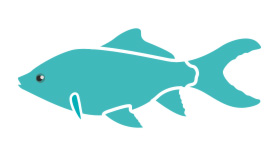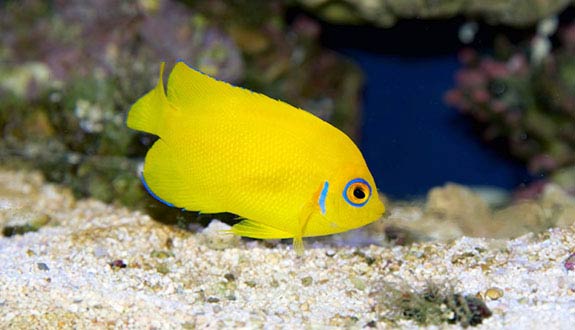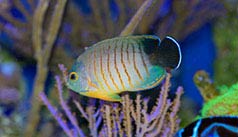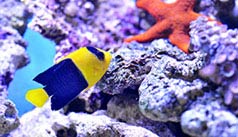

Alternative species (click on the thumbnail to see the card)
Names
Scientific name
Centropyge flavissima
Centropyge flavissimus
Common name
Lemon Peel Angel
Lemonpeel angelfish
Lemonpeel Dwarf Angelfish
Origin

Origin: Pacific Ocean and Indian Ocean
Natural habitat: it evolves in zones rich in corals, up to 20 m (66 feet) deep
Dimorphism

the male is much larger than the female
Group

Pomacanthidae
Volume

300 L / 66 imp gal / 79 US gal
Parameters

T°: 23 à 26°C or 73 to 79°F
pH: 8 to 8.5
Density: 1021 to 1026
Difficulty

Easy
Size

from 10 to 14 cm (4 to 5.5")
Longevity

10 years
Living zone

Middle and depth
Individuals

1 or harem
Food
How to feed the Lemon Peel Angel?
Food
How to feed the Lemon Peel Angel?
The diet of this fish is omnivorous with a vegetarian tendency. For balanced menus, plan a vegetarian and a meat portion at each meal. For the meat part, you can offer chironomid larvae, mysis, enriched artemia, krill, tubifex and chopped mussels (especially the mantle) . The vegetable part can consist of algae such as spirulina or Nori, and salad, broccoli or spinach.
This active fish spends a lot of energy! So it has a good appetite and you will have to feed it several times a day with small quantities (at least twice a day).
When it arrives, prefer fresh and live food, then after a good acclimatization, you can switch to frozen and/or dry food.
Behavior
What kind of behavior does the Lemon Peel Angel have?
Behavior
What kind of behavior does the Lemon Peel Angel have?
He is an active swimmer who spends his day grazing on the algae in the scenery.
This fish is easily frightened and must therefore be secured to avoid stress. To do so, install a large rock formation that will provide shade and hiding places. Your fish will not move away from this shelter!
Cohabitation
Who can live with the Lemon Peel Angel?
Cohabitation
Who can live with the Lemon Peel Angel?
In the majority of aquariums, it is better to be satisfied with a single individual of this species. Indeed, in an aquarium of less than 1000 liters , the Centropyge flavissama does not support the presence of its congeners. From 1,000 liters/ 220 Imp Gal / 265 US Gal, install at least 3 Centropyge: 1 male and 2 females. Note that cohabitation will have a better chance of success if all the Centropyge in the tank (whatever their species) are introduced at the same time, if possible young enough.
The relationship that a Centropyge flavissama has with its roommates will depend mainly on the character of the individual: some are perfectly peaceful while others have a more quarrelsome temperament. This is especially the case with fish smaller than him. Therefore, it is preferable to add larger fish with a peaceful temperament.
The installation of corals is possible in large aquariums. Indeed, this Centropyge has a tendency to nibble the polyps of invertebrates. Therefore, the larger the volume and number of corals, the less damage will be problematic. A minimum of 500 liters / 110 Imp Gal / 132 US Gal will thus be necessary to introduce this species in a reef aquarium. If this behaviour becomes recurrent, there is probably a lack of variety in the diet of your Centropyge: offer very different meals and use either specialized foods or food supplements.
Breeding
How to breed the Lemon Peel Angel?
Breeding
How to breed the Lemon Peel Angel?
The main obstacle to the reproduction of this species is the volume required: nearly 1,000 liters / 220 Imp Gal / 265 US Gal. Indeed, reproduction is only possible in hierarchical groups of 3 to 10 individuals (1 dominant male and 2 to 9 mature females).
The dominant male will choose a female and will parade around her on his way to the surface. Fertilization is external: eggs and sperm will be emitted by the couple just below the surface. This operation will be repeated several times. A complete reproduction can produce 200 to 300 floating eggs.
Retrieve the eggs quickly after laying and introduce them into a breeding aquarium. The water parameters must be impeccable: 26/28°C or 79/82°F, pH between 8 and 8.2 and density between 1,022 and 1,024). Incubation lasts between 16 and 20 hours (sometimes more) at 27/28°C or 81/82°F. After hatching, the young fish measure only 2 mm but have a small food stock for 3/4 days.
It will be necessary to wait 2 or 3 weeks before the yellow of their coat starts to appear. The larvae undergo two transformations before reaching the juvenile stage: one on the 45th day, then another on the 70th day.
Fry food: rotifers.
Interesting fact: all Centropyge flavissama are born as females and some evolve into males afterwards!
Its aquarium
Which aquarium for the Lemon Peel Angel?
Its aquarium
Which aquarium for the Lemon Peel Angel?
The decoration of the Centropyge must be composed of an important rocky part offering many hiding places: holes, caves, interstices... The more fallback areas there are, the more comfortable your fish will feel in its aquarium.
Complete with filamentous green algae that will also be part of its diet.
The presence of corals is possible if they are in sufficient numbers and in an aquarium of at least 500 liters/ 110 Imp Gal / 132 US Gal.
Finally, this fish appreciates a fairly strong current and good mixing.
Good To know
Find all additional information!
Good To know
Find all additional information!
Easy to acclimatize and rather robust, this fish can be maintained by a beginner aquarist. To note all the same its sensitivity to parasites.
To choose your fish, observe it well: its skin must be healthy, it must not be injured and it must be moving all the time.
Beware of its resemblance to the Centropyge Heraldi which has no blue circle around the eye. Juveniles can also be confused with the surgeon Acanthurus Pyroferus.
Hybridization is possible with Centropyge vrolikii and Centropyge Eibli.
There are 32 species of Centropyge (or dwarf angelfish), making it the best represented genus of their family, the Pomacanthidae (or angelfish), which has 88 species in all.
Yours photos!
Comments
Sort by:
Please login to post comments



